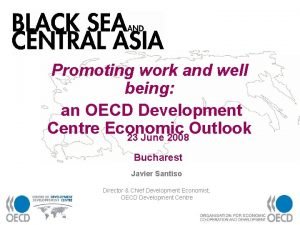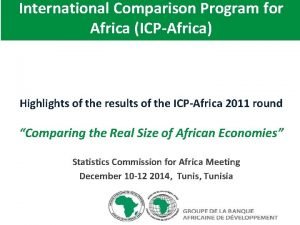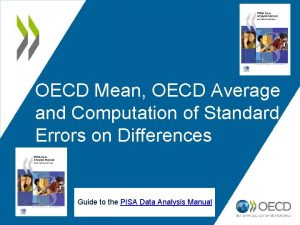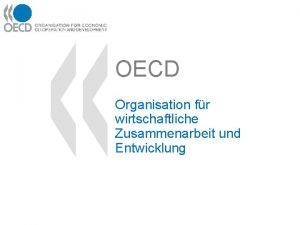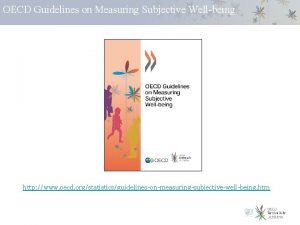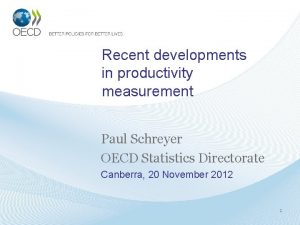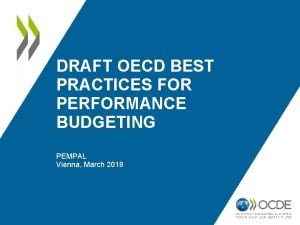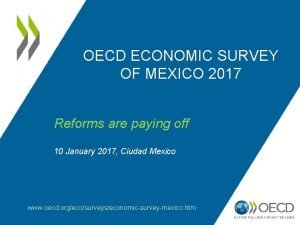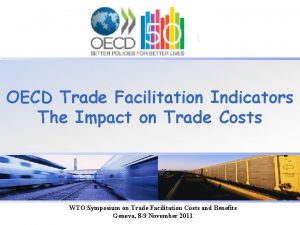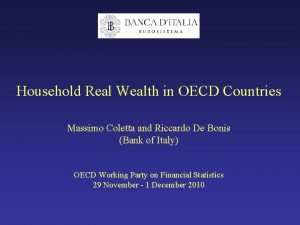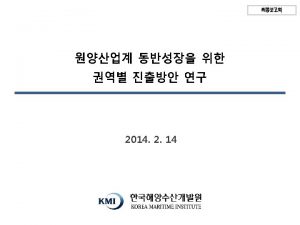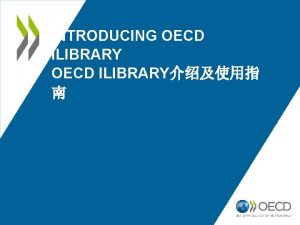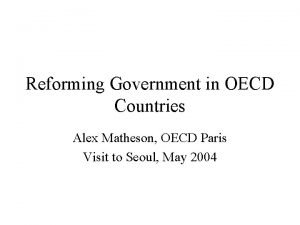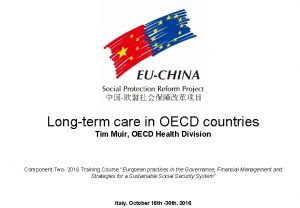Household Real Wealth in OECD Countries Massimo Coletta













- Slides: 13

Household Real Wealth in OECD Countries Massimo Coletta and Riccardo De Bonis (Bank of Italy) OECD Working Party on Financial Statistics 29 November - 1 December 2010

Motivation • Non-financial assets make up, together with financial assets, household total wealth • Real assets may impact on consumption (the “wealth effect”) and are a buffer against macroeconomic shocks • In the aftermath of the recent crisis, statistics on real assets have become more relevant to better monitoring price movements and to detect bubbles that would threaten economic stability • The Inter-Agency Group on Economic and Financial Statistics set up by the IMF has identified as area of data improvement also the sectoral balance sheets, particularly of households and non-financial corporations (recommendation #15) 2

Outline 1. Data 2. What do the data say? 3. Issues for discussion 3

1. Data National statistics on real wealth are non homogeneous, because of different methodologies household real assets and/or the component dwellings A minority of countries also provides estimates of the value of land and, as a memo item, of durables Probably the column “land” is not comparable across countries. In some countries the land is the “land underlying buildings” plus “the agricultural land” (e. g. France). In other countries the land includes only the agricultural land (e. g. Italy) 4

1. Data (follows) • Some countries have estimates of real assets but the data are not transmitted to the OECD: e. g. Bank of Spain publishes statistics on its website • According to the breakdown of the table 7 HAL: – 9 OECD countries transmit both total real assets and dwellings – 11 countries provide only the total or the dwellings – 14 countries do not provide info on real assets even partially 5

Data availability 6

2. What do the data say? • The following table shows the ratio of household real wealth to disposable income for 20 countries • We consider also countries that give only data on dwellings • The hypothesis is that dwellings represent the larger component of household real wealth 7

Real wealth/disposable income * Only dwellings 8

2. What do the data say? We can distinguish countries into three groups • Six countries have a ratio around 2: e. g. the US, Czech Republic, Denmark, Israel, Norway • Other countries have a ratio between 2 and 4: e. g. Belgium, Canada, Japan, and Germany • A last group of nations has a ratio greater than 4: Australia, New Zealand, the UK, France, Italy, and Spain. The highest value is found in Spain: it is very relevant considering that only dwellings are taken into account ! 9

2. What do the data say? Financial assets • In most of the countries the ratio of household financial assets to disposable income is lower than 4 and/or smaller than real assets • On the contrary Belgium, Canada, Denmark, Japan, the Netherlands, Switzerland, the UK and the US have higher financial wealth, that is often greater than real assets 10

2. What do the data say? Net worth to gross disposable income • Finally we looked at the ratio of total net worth sum of net financial and real assets - to disposable income • Australia, Israel and New Zealand are not computed because their financial data are not in the OECD website • We adopted a threshold of 6 to select the wealthier countries • 9 countries are above 6: Spain (an outstanding value!) but also the UK, Switzerland, Italy, Japan, and France. 11

Net worth to disposable income 12

3. Issues for discussion • In most of the countries real wealth is greater than financial assets • Sometimes real wealth is negatively linked to the size of a country (look at Norway, Fin, and the US) and positively to the population density, as it is in the UK, FR, and IT. But there are exceptions like Aus and NZ, where real assets are large • Of course real assets are influenced by other causes: demographic trends, price bubbles, weight of finance etc. • Should countries clarify some methodological issues? May the land be more important than dwellings, like in France and Japan? • Are producer households an issue? • Might new data change the economic interpretations? 13
 Oecd countries
Oecd countries Countries by real gdp
Countries by real gdp William hynes oecd
William hynes oecd Oecd nations meaning
Oecd nations meaning Oecd
Oecd Oecd qsar toolbox
Oecd qsar toolbox Melinda brown oecd
Melinda brown oecd Oecd guidelines on measuring subjective well-being
Oecd guidelines on measuring subjective well-being Paul schreyer oecd
Paul schreyer oecd Oecd good practices for performance budgeting
Oecd good practices for performance budgeting Oecd economic outlook
Oecd economic outlook Oecd trade
Oecd trade Daniel gerson oecd
Daniel gerson oecd Guidance on transfer pricing aspects of intangibles
Guidance on transfer pricing aspects of intangibles
